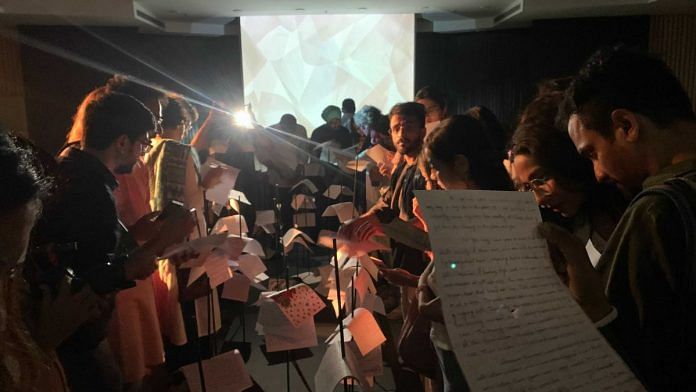New Delhi: A death-row prisoner writes to his lawyer, expressing delight at being given a book penned by Savitribai Phule. “I would like to know more about this great lady, and that I will do [it] myself. You don’t have to worry about that,” the letter read. Another writes about him learning English to read his case file. “In 2019, I received a paper book of my case. Right now I am reading it,” he wrote. These prisoners, represented by the legal team of Project 39A at Delhi’s National Law University, often write to their lawyers.
These are just two of the several letters that the equal justice and equal opportunity social group receives from its clients, who are in prison on death row across India. Their letters are now part of a new online exhibition—You Know I Can’t Say More—that offers a peek into the intimate fragments of their lives.
“They give you the death penalty, only to keep you alive for decades,” Maya Krishna Rao thundered during her performance at the launch of the archive at Delhi’s India International Centre.
Through a segment titled, ‘If you really want to know my story,’ Rao showcases the brutality—from the scene of crime to inmates in prison. She also pointed out that, statistically, 74 per cent of death row prisoners belong to the oppressed castes and communities.
As an artist, Rao is known for her solo theatrical performances. Using a chair as a prop, Rao referred to it as an instrument of violence, as prisoners expect to be tortured when seated on it.
The event, which also included a performance by singer TM Krishna, was an attempt to bring new perspectives to the contentious, hotly debated topic of death penalty.
Also read: ‘Blatantly erroneous’ — how 56 death sentences in 14 months defied latest Supreme Court guidelines
Humanising prisoners
In a room bursting at the seams, the theatrical and musical performances were followed by a panel discussion. Project 39A’s executive director Anup Surendranath explained the organisation’s work and highlighted the purpose behind the exercise.
“A decade of correspondence [with prisoners] made us feel like there was insight we must convey. Very often academic writing is so limiting. It doesn’t have that kind of impact. The kind of suffering you’re routinely exposed to numbs you, and these are powerful reminders,” he said.
The evening was dedicated to Jeetendra Shinde, a prisoner at Bhilwara Jail in Rajasthan who died by suicide, one of the three such inmates represented by Project 39A.
The overarching idea behind the project is the humanisation of death row prisoners. Of all the letters scoured by Project 39A and ReFrame, an art organisation responsible for curating the exhibition, only one prisoner spoke of a happy and secure childhood, said Vani Subramaniam, documentary filmmaker and director of ReFrame.
While certain documentation, such as the prisoners’ last words, do make it into the public domain, there is a lot left to the imagination. The project taught the team “how disengaged the entire process is.”
In their attempt to bridge the differences between ‘ordinary people’ and ‘prisoners’, the panellists referred to the contents of the letters. “There’s pain, there’s joy, there’s hope. A lot of what they are sharing is not so different from what we go through. Our own struggles, dilemmas, childhood traumas,” Subramaniam said.
TM Krishna, who performed two compositions, introduced the pieces by urging the audience to think about the discomfort associated with both death and the death penalty. “Death is graded,” he said, implying that some deaths mean more than others.
Krishna’s unwavering message to the audience was that death penalty should be seen “as an act of violence”. “Let’s call it what it is, a killing,” he said.
The exhibition is available on capitalletters.in.
(Edited by Theres Sudeep)



